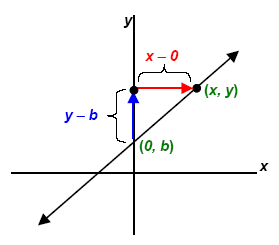The Slope of a Line
Recall the RATIO of the y-difference (dy) to the x-difference
(dx). Another name given to this RATIO is slope –designated m because the move is frequently on a slope up or down. We will examine
its characteristics of this ratio and look at the equations for which we have built tables with the ratio
of their differences.
When you draw a straight line, one of four things happen: [Read all graphs left to right.]
a)
 |
b)
 |
c)
 |
d)
 |
| Goes up from left |
Goes down from left |
Is horizontal |
Is vertical |
By this time we have learned the relationship of the RATIO which determined the
MOVE of our graph
from one point to the next. We can determine the plot of the graph if we can find a starting place
(point) and the ratio (move).
We have investigated the move up from a point dy (vertical difference between points) and
over dx (horizontal difference between points) to the next point. The RATIO of the differences
is called slope, always a "rational number"
 . .
If we are given two points (0, b) and (x, y), we can FIND the slope m and we can WRITE
the equation for the line in the slope-intercept form: y = mx + b
 |
 |
 |
 |
 |
 |
Multiply each side by x. |
 |
Solve for y: |
If we compare the values we have found in the these steps, we see that the value for m (move) and
y-value ,b when x = 0 (y-intercept), appear in this new equation. In textbooks this is referred to as
the slope-intercept form of a linear equation, which is the only FORMULA we really need.
y = m x + b
|